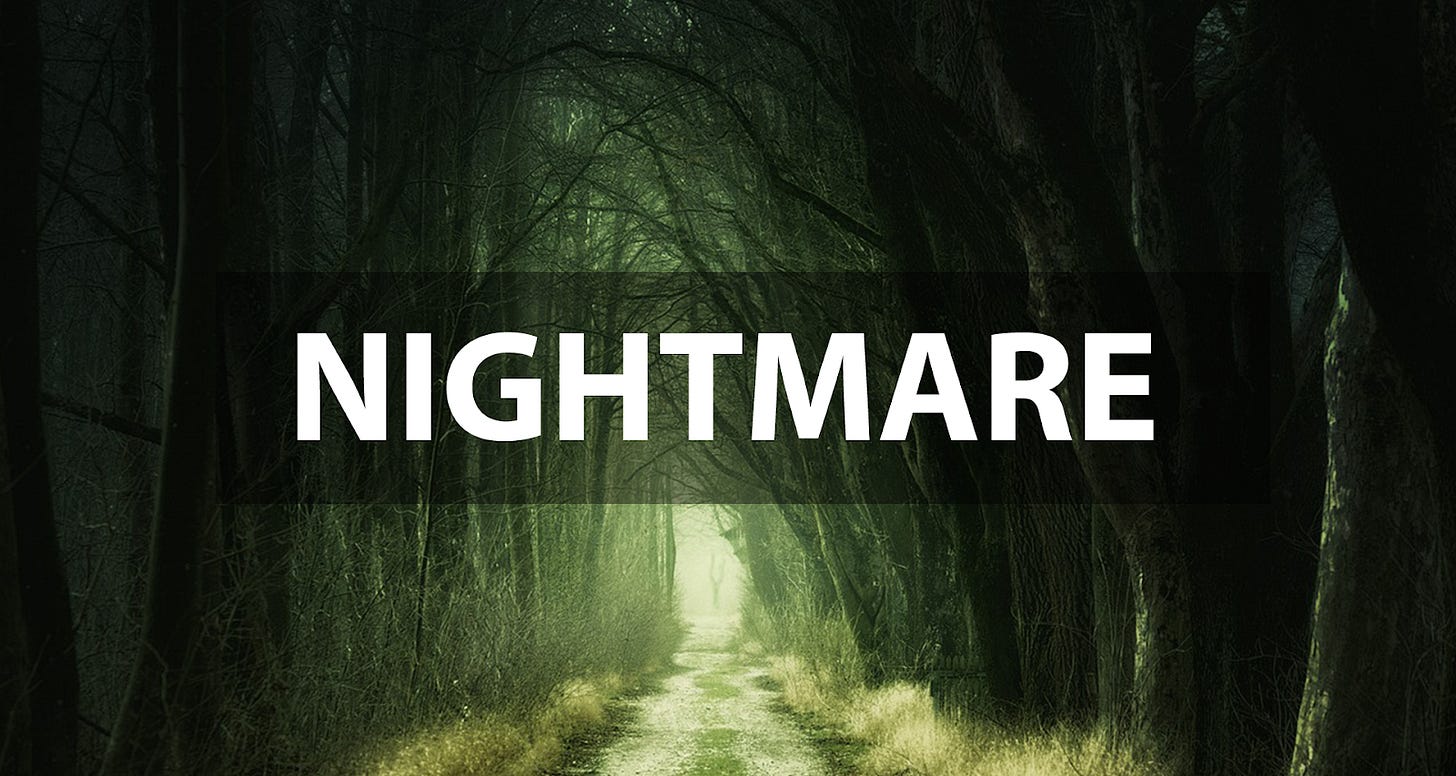5 Common Words With Literal Goblins Hiding Inside
You’ll never look at pumpernickel the same way again.
Halloween is still more than 100 days away, so it’s troublingly early to be turning up the spookiness dial (yes, we have a spookiness dial), but there’s no law I’m aware of that says you can’t talk about goblinwords™ in the summer if you feel the urge, and so here we are. The sun may be beaming obnoxiously, the blathering birds spreading their dubious avian gossip, the happy schoolchildren skipping, hand-in-hand, on their way to summer camp—but we are pulling down the shades, lighting a spooky-ass candelabra, and descending ethereally into our cobwebby basements to look for some absolutely outrageous goblins who have been hiding in plain sight this whole dang time.
These … are the goblinwords.™
The “night” in nightmare is a standard-issue night, but the “mare” isn’t a horse at all. It is, in fact, a whole-ass goblin, which explains why it’s so damn scary to have one even if you’re not a hippophobe. This mare, via the Old English mære (demon) is the only surviving English descendent of the Proto-Germanic *maron, meaning “goblin.”
According to Medieval folklore, these little nasties ride on your chest while you’re sleeping and subject you to unholy torments like reliving your high school Chemistry final—but if you’ve been reading up on the 9th century medical treatise Bald’s Leechbook, you’ll know that there’s a super easy way to get rid of them (as long as you have some fawnskin handy):
Gif mon mare ride genim elehtran & garleac & betonican & recels, bind on næsce, hæbbe him mon on & he gange in on þas wyrte.
If a mare ride a man, take lupins & garlic & betony & frankincense, bind them in a fawn’s skin, let him have the worts on [him], & let him go on [his way]. (Translation via Wordorigins.org)
And now the really bad news—night-mares aren’t the only kind of mares. The 1883 dictionary Anglo-Saxon and Old English Vocabularies, by Thomas Wright, has a note about the “wood-mare ... a spirit which dwelt in the wilds and mocked people who passed there, as the night-mare tormented people in bed.” It’s unclear whether you can also shoo these beasts away with lupins & garlic, but you might as well carry some next time you go hiking, just in case.
Everyone’s favorite transition metal (sorry, Scandium fans!) has a sneaky goblin secret that would get it kicked right out of the D-Block if anyone ever found out. (Please don’t fact check me on any of this stuff — I failed high school Chemistry. Still have nightmares about it.) Scandalously, the word Cobalt comes from the Middle High German word kobold, meaning “household goblin.”
Kobold is a compound of kobe, meaning “hut,” and *holt, which came to mean “goblin” as a euphemistic derivation from hold, meaning “gracious and friendly.” This seems odd, but superstitiously calling a mischievous demon “Friendly One” as a way of staying on their good side has a venerable history—you can see a similar tactic at play in a Greek word for The Furies (who were not very nice at all): Eumenides means “Kindly Ones.”
Cobalt gets its name from a reputation for being “a demon of the mines,” because Cobalt ores often gave off arsenic fumes when they were smelted. This seems like rather an unfair nickname to give to something that never asked to be smelted in the first place, but—and I hope this is the last time I have to say this—I’m not here to litigate the moral maturity of 17th century German miners.
OK, I’m aware of how bad this looks for me, but I’m not going to be able to make sense of this next one without wading just a little bit into the tricky subject of moral maturity in 17th century German miners. These guys, it seems, were irrationally annoyed by basically all of the elements they were busy smelting without so much as a by-your-leave, and when they stumbled upon everyone’s second-favorite transition metal (again, my heartfelt apologies to the Scandium-heads), things got kind of nasty.
Nickel ore, apparently, looks a lot like it’s going to yield Copper with just a little bit of sweet, sneaky smelting … but it doesn’t. It yields Nickel. This is the sort of thing that drives a 17th century German miner all the way up the proverbial mine wall, which is why they named the stuff kupfernickel, from kupfer, meaning “Copper,” and nickel, meaning—you guessed it—“Goblin.” Eventually the kupfer part dropped off, and that is why we have not one, but two extremely important elements irresponsibly named after literal demons by you-know-who (🇩🇪⛏🙄).
Which brings us to pumpernickel, aka, “fart-goblin.” The nickel in Pumpernickel comes from the same root as the nickel in Nickel—a goblin or demon, as in the 17th century epithet for the Devil, Old Nick. It’s either a reference to Niccolo Machievelli’s first name, a shortened form of iniquity, or a relic of some generalized distaste for people named Nicholas that’s been lost to history. And pumper is from the Westphalian German pumpern, which means “to fart.”
Word on the street is that the heavy Westphalian bread didn’t agree with the digestion of the German soldiers who encountered it after the 30 Years’ War, so they named it pumpernickel. Fart-goblin.
Cards on the table — I think lemurs are cute as hell. They have bushy tails and they carry their babies on their backs and they’re all wearing preposterous granny glasses that make them look like perpetually annoyed librarians. But that’s not how Carl Linnaeus felt, and Carl Linnaeus is the 18th century Swedish botanist who apparently gets exclusive naming rights to any adorable Madagascar monkey-cats he happens to come across.
And so we have lemurs, from the Latin lemures, which refers to the restless spirits of the malevolent dead who terrorized Romans as revenge for their violent murders. The association with lemures has led to a belief that lemurs were so-called because they look like freaky skeletal zombie-wraiths, but Linnaeus explains himself differently in his Systema Naturae:
“I call them lemurs because they go around mainly by night, in a certain way similar to humans, and roam with a slow pace.”
This explanation is much nicer than the zombie-wraith thing, but it does make you wonder why this suspicious Swedish botanist knows so much about how Roman vengeance goblins behave in real life.
In golf, a “bogey” is a score of one stroke over par for a hole. If you don’t know what that means, it’s probably knowledge you’ve decided to avoid in your life, and I’ll respect that—just know that a “bogey” is a well-known golfy thing that golf-people say sometimes. But what makes it interesting is its surprisingly direct connection to the childhood horror known as the bogeyman. The Oxford English Dictionary gives this passage from a 1908 article to explain the word’s origin:
One popular song at least has left its permanent effect on the game of golf. That song is ‘The Bogey Man’. In 1890 Dr. Thos. Browne, R.N., the hon. secretary of the Great Yarmouth Club, was playing against a Major Wellman, the match being against the ‘ground score’, which was the name given to the scratch value of each hole. The system of playing against the ‘ground score’ was new to Major Wellman, and he exclaimed, thinking of the song of the moment, that his mysterious and well-nigh invincible opponent was a regular ‘bogey-man’. The name ‘caught on’ at Great Yarmouth, and to-day ‘Bogey’ is one of the most feared opponents on all the courses that acknowledge him.
The Bogey Man in the song (a truly terrifying Music Hall number called “Hush Hush Hush, Here Comes the Bogey Man”) shares a common origin with the words “Bug,” “Bugaboo,” “Bogus,” “Bugbear,” and “Boggle,” which likely come to us via the Scottish bogill and the Welsh bwg, two words that both mean—say it with me—“Goblin.”












I thought this one was particularly interesting.
So the mare appears not a mere mare! 🤯
💬 (🇩🇪⛏🙄) <-- 👌😂